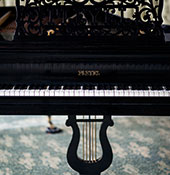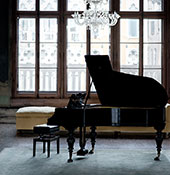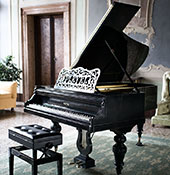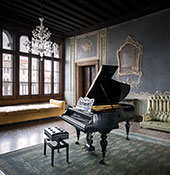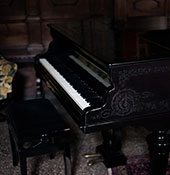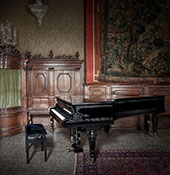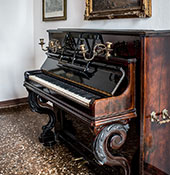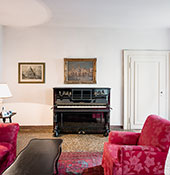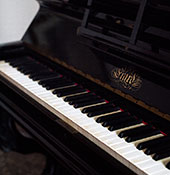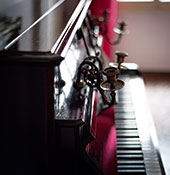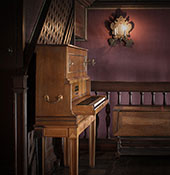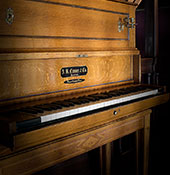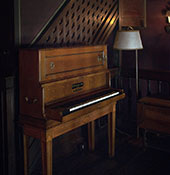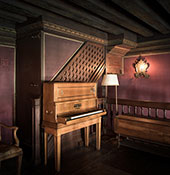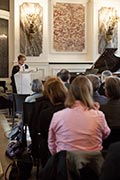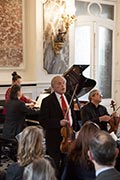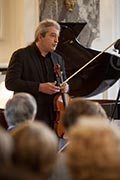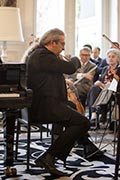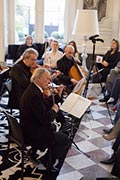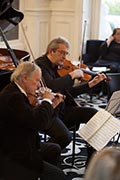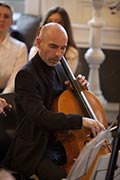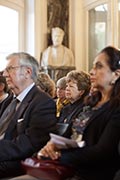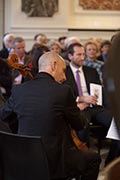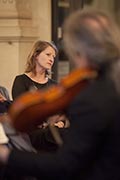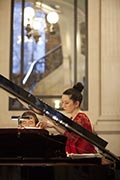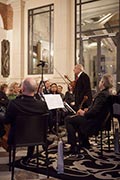Palazzo
Palazzo Contarini Polignac is one of the most important early renaissance buildings, also known as Contarini dal Zaffo. Its façade is covered with marble and resembles to a tuscan classicism. Most likely it was designed by Giovanni Buora, although the older scholarship (Angelini 1945 etc.) would like to attribute the palace to Mauro Codussi. Especially the details of the zone between the water floor and the first piano nobile are remarkable. In comparison to earlier buildings, the water floor's window surface is large; but the type is alike. The lateral façade on the garden of Palazzo Balbi-Valier Sammartini has a loggia of three arches. It is still unknown who owned the palace in the late fifteenth century. A Contarini appears in a document from 1758, when the building was sold to the merchant Manzoni. Two friezes by Domenico Tiepolo, which once were in the palazzo Correr a Santa Fosca, are still conserved in this building as well as stucco decorations in the second piano nobile. At the beginning of the 20th century, the salon of the Princess Winnaretta de Polignac, nee Singer, which had great importance for the musical avant-garde in Europe, was held in this palace - beneath others, Ethel Smyth and Igor Stravinsky were guests in Palazzo Contarini. The façade was restored from 2004 to 2007 with good results.
Palazzo Contarini Polignac dal Zaffo- by Raffaella Russo
In the days of the Serenissima, as the Republic was known, this palace was called the Palazzo Contarini dal Zaffo alla Carità, the word Zaffo derived from the city of Jaffa. The Contarinis were wealthy landowners with several estate in the Near East, and because they were unable to confer upon themselves the title of Lords of Jaffa, they decided to attach the name Zaffoto their own. The Contarinis, who took part in the election of the first doge in 697, were one of the oldest families in Venice. Their rootsgo right back to the Roman Aurelia Cotta clan, which was the family of Caesar’s mother. They became prefects of the Rhine and their name is probably a contracted form of Cotta Rheni (counts of the Rhine).
We know nothing about the earliest owners of this palace, which was acquired by the Contarini dal Zaffo family in the latter half of the sixteenth century. The palace, which was probably built in the late fifteenth century was in fact attributed to both Mauro Codussi and Giovanni Buora. At the end of the eighteenth century, Giandomenico Tiepolo covered the rooms with rich decorations, but unfortunately, only a few fragments of this work have survived to this day.
Towards the end of the eighteenth century, the residence was sold to Domenico Manzoni, a silk merchant, and in the early twentieth century, after changing hands several times, the palace was bought by the princess of Polignac. The princess of Polignac was not only a connoisseur and patron of the arts, but also a painter and musician herself. She enjoyed the friendship of Sargent and Picasso, and her slaon on the Grand Canal was every bit a match for the most celebrated European salons of the day.
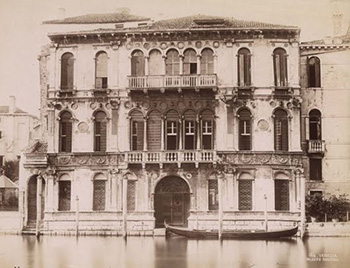
The 4 Pianos of Winnaretta Singer
The Palazzo Contarini Polignac has four important pianos in its collection, an 1898 Pleyel, an 1885 Erard, an 1882 Erard upright and a five-octave portable piano made by JB Cramer of London in 1898.
The instruments were owned by Winnaretta Singer and have been expertly restored this year by Gérard Fauvin in Pétignac. All three were played at various times by an impressive roll-call of virtuosi. Among these were Gabriel Fauré, Reynaldo Hahn, Francis Poulenc, Darius Milhaud, Manuel de Falla, Maurice Ravel, Jacques Février, Nadia Boulanger, Clara Haskil and Vladimir Horovitz.
The Pleyel (No. 119839)
The Pleyel (No. 119839), manufactured in 1898, is a fine piece, made in ebony and veneered mahogany, decorated with brass inlay and having distinctive acanthus-leaf pedestals. Much praised and played by Chopin, Pleyel models of this type were known for their robust 'orchestral' timbre but were nevertheless capable of sustaining a delicate melodic line. Francis Poulenc played through Ravel's Piano Concerto in G on this instrument - while Jacques Février provided the orchestral accompaniment on the Erard.
The Erard (No. 58784)
The Erard (No. 58784), manufactured in 1884 is a fine example of the manufacturer's work of this period, made in ebony and veneered mahogany and adorned with floral decorations bearing Winnaretta’s initials. It has elegant, fluted pedestals - very much an Erard feature of the period. The instrument has an impressive and colourful dynamic range and was much favoured by Liszt.
The Erard upright piano (No. 69255)
The Erard upright piano (No. 69255) was manufactured in 1892 and sold to Winnaretta Singer in the same year in Paris. The seven-octave instrument is made of ebonized rosewood with an ivory and ebony keyboard. Interesting characteristics include four perfectly preserved candlesticks and a pair of bronze handles. The handles were designed to facilitate the transportation of the instrument. They are also useful for moving it easily and quickly around a household for different types of musical events.
The Cramer portable piano
The Cramer portable piano, manufactured in 1896 (No. 27366) is a distinctly English piece made in veneered oak with a pearwood five-octave keyboard. Winnaretta acquired the instrument shortly after its manufacture and among the first of her friends to play it was Gabriel Fauré. In 1900, shortly before she bought the Palazzo Contarini-Polignac, Winnaretta visited Venice with a number of friends including Marcel Proust and Reynaldo Hahn. On one memorable evening, the piano was installed on a gondola and Hahn entertained the company with moonlit renditions of his songs.
Association
Les Amis de Winnaretta Singer
Association des Amis de Winnaretta Singer (The Association of the Friends of Winnaretta Singer), created in 2015 in Paris, is a continuation of her moral, artistic and intellectual heritage. The Association wishes to call attention to the important work of Winnaretta Singer, for science, literature, the arts, culture in general and philanthropy, especially in the musical domain. In this context, the Association organizes cultural and musical events in Venice and elsewhere, and collaborates and supports artistic projects in this spirit.
The concerts organized at the Palazzo Polignac in Venice during the "musical weekend" of 7-8 November 2015 will be the first official event of the Association.
Assemble Générale 24.04.2017
| Bulletin renouvellement d'adhésion 17 | |
| Invitation | |
| Programme |

